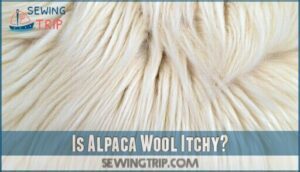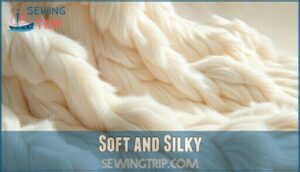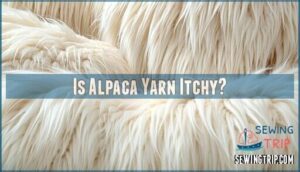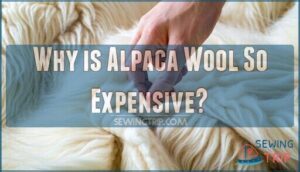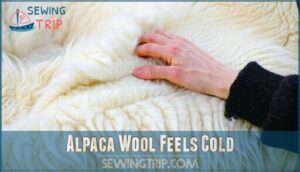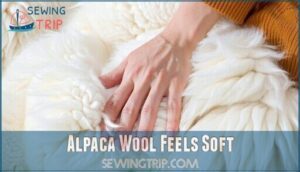This site is supported by our readers. We may earn a commission, at no cost to you, if you purchase through links.

The fibers are incredibly soft and smooth, lacking the scratchy bite you’d expect from sheep’s wool. You won’t experience that annoying itch that makes you want to tear off a sweater after five minutes.
Alpaca’s hollow fiber structure creates a lightweight feel that’s both breathable and warm – think of it as nature’s climate control system.
The texture has a subtle bounce when you compress it, springing back like memory foam.
There’s much more to discover about why alpaca outperforms other natural fibers.
Table Of Contents
Key Takeaways
- You’ll feel alpaca wool’s surprisingly cool, silk-like texture against your skin – it’s smooth and soft without any scratchy bite that sheep’s wool creates.
- You won’t experience itchiness because alpaca fibers lack lanolin and have smooth surfaces with minimal protruding scales, making them perfect for sensitive skin.
- You’ll notice alpaca’s unique hollow fiber structure creates a lightweight yet substantial feel that bounces back like memory foam while providing natural climate control.
- You’re getting premium quality when you touch genuine alpaca – it rivals cashmere’s luxury at a lower price point and maintains its softness even after washing.
What is Alpaca Wool Called?
Alpaca wool goes by several names, but most commonly you’ll hear it called "alpaca fiber" or simply "alpaca fleece." Historically, the Incas treasured this material so much they dubbed it the "Fiber of Gods" – reserved exclusively for royalty.
Today’s alpaca names origin traces back to the Quechua word "paqocha." The alpaca texture you’ll encounter depends on breed distinctions.
Huacaya alpacas produce dense, crimped fleece that feels bouncy and cloud-like. Suri alpacas create silky locks that hang in lustrous curtains. Both types deliver that distinctive alpaca feel that’s softer than sheep’s wool.
Regional variations exist too. Peruvian producers often use wool grading terms like "blanket" for finest fibers and "seconds" for coarser grades. Whether you’re shopping for alpaca wool sweaters or throws, understanding these distinctions helps you choose the right alpaca fiber for your needs.
Is Alpaca Wool Itchy?
You’ll be relieved to know alpaca wool rarely causes itchiness, thanks to its unique fiber structure.
Unlike sheep’s wool, alpaca lacks lanolin and has a low micron count (15-30), creating smooth fiber surface scales that won’t irritate sensitive skin.
The prickle factor is virtually nonexistent because alpaca fibers protrude only 0.3-0.4 microns from the surface, making pure alpaca wool a great choice for comfort.
However, blending impacts can change this – lower-quality blends with coarser materials might feel scratchy, which is why pure alpaca wool remains your best bet for itch-free comfort, and it’s due to the unique fiber structure.
What Does Alpaca Feel Like?
When you first touch alpaca wool, you’ll notice it feels surprisingly cool against your skin, almost like touching smooth silk or fine cashmere.
Alpaca wool greets your fingertips with an unexpectedly cool, silk-like whisper that defies every expectation.
The fibers create a soft, silky texture that’s completely itch-free, making it comfortable for even the most sensitive skin types, with a feel that’s almost like silk.
Cold to The Touch
Touching genuine alpaca wool for the first time, you’ll notice its surprisingly cool temperature against your skin.
This cold when touched sensation comes from alpaca fiber’s unique material composition and heat conductivity properties, creating an initial impression that differs from synthetic alternatives.
Here’s what makes this luxurious feel so distinctive:
- Your fingers detect the fiber structure’s natural cooling effect immediately
- The soft alpaca material feels invigoratingly crisp, not warm like expected
- This sensory perception signals authentic, high-quality alpaca wool versus imitations, providing a clear indication of high-quality materials.
Soft and Silky
Imagine wrapping yourself in a fabric that feels like a whisper against your skin—that’s the magic of soft alpaca wool.
Its silky texture comes from a fine fiber diameter, giving it a luxurious feel often compared to cashmere, but at a friendlier price.
This tactile quality makes alpaca fiber perfect for garments that drape and flow elegantly, like scarves or shawls.
Its softness isn’t just about comfort; it’s about indulgence, making every piece feel like a treat.
Whether for warmth or style, the silky texture elevates any wardrobe with timeless sophistication.
Itch-free
Unlike sheep’s wool that can leave you scratching, alpaca fiber delivers remarkable comfort for sensitive skin.
The secret lies in its unique structure—alpaca fibers have a larger diameter and smoother cuticle cells that barely protrude from the surface. This lanolin absence means you won’t experience the typical itchiness associated with traditional wool.
Your comfort level stays consistently high throughout wear.
- Hypoallergenic properties protect against skin irritation
- Smooth fiber surface eliminates prickly sensations
- Natural softness rivals luxury fabrics like cashmere
- Eco-friendly production supports sustainable fashion choices
Is Alpaca Yarn Itchy?
Most alpaca yarn won’t make you itch, thanks to its incredibly fine fiber diameter and zero lanolin content.
You’ll find alpaca’s prickle factor stays low because the fibers measure just 15-30 microns with smooth surfaces.
People with skin sensitivity or wool allergies often choose alpaca over sheep’s wool since it lacks the scratchy scales that cause irritation.
Higher alpaca grades feel even softer, while blending options can adjust texture.
If you’ve struggled with itchy sweaters before, alpaca yarn offers a gentle alternative that keeps you comfortable all day, providing a solution with its fine fiber diameter.
Why is Alpaca Wool So Expensive?
Behind every luxurious alpaca wool garment lies a complex web of factors that drive up its price.
Behind every soft alpaca fiber lies nature’s most luxurious secret—a treasure worth every penny.
Supply and demand play the biggest role—alpacas can only be shorn once yearly, creating a limited supply that can’t keep pace with growing demand.
While shearing sheep costs just $2-$4 per animal, alpaca shearing runs $32 each due to specialized handling requirements.
The fiber quality justifies these breeding costs and processing expenses.
Manufacturers pay $2 per ounce for alpaca fleece compared to $0.11 for sheep’s wool.
This premium reflects the intensive labor needed for sorting, cleaning, and processing these delicate fibers.
Ethical sourcing adds another layer of cost, as responsible farms invest heavily in animal welfare and sustainable practices.
When you consider that each alpaca produces only 2-5 kilograms of wool annually, the price suddenly makes perfect sense.
Some Basic Facts About Alpaca Wool
Understanding alpaca wool’s price point leads naturally to exploring what makes this fiber special.
Here’s what you should know about this remarkable material:
- Alpaca Origins: These South American camelids produce fibers ranging from 15-30 microns in diameter
- Wool Grades: Two breeds exist – fluffy Huacaya and silky Suri varieties
- Fiber Diameter: Smaller than sheep’s wool, creating that luxurious feel
- Natural Colors: Available in 20+ shades from white to black
- Wool Production: Annual shearing yields hypoallergenic, lanolin-free natural fibers with exceptional softness
The details provided highlight the unique characteristics of alpaca wool, making it a valuable and sought-after material.
Alpaca Wool Feels Cold
When you first touch alpaca wool, its coolness factor immediately surprises you.
This tactile perception stems from the fiber’s unique fiber conductivity properties that create efficient heat dissipation from your skin.
The smooth feel and silky texture contribute to this cool feeling to the touch, making it distinctly different from other wools.
This sensory experience occurs because alpaca fibers have a naturally smooth surface structure.
The softness doesn’t compromise this coolness – instead, these qualities work together to create alpaca wool’s signature luxurious feel.
This combination of coolness and softness makes alpaca wool unique, providing a distinct sensory experience.
Alpaca Wool Feels Soft
Touch alpaca wool and you’ll understand why it’s called "the fiber of the gods." The softness rivals cashmere but comes at a fraction of the price.
This luxurious feel stems from alpaca’s unique fiber diameter – typically 15-30 microns compared to sheep wool’s rougher 40+ microns. You can’t help but notice the silky texture when you run your fingers across genuine alpaca garments.
The smooth feel comes from naturally occurring scales that lie flat against each fiber, creating that signature velvety sensation. Unlike synthetic alternatives, real alpaca maintains its softness retention even after multiple washes.
When comparing cashmere vs. alpaca, you’ll find alpaca offers similar luxury without the premium price tag. Blending effects with other natural fibers enhance drape while preserving that cloud-like softness. Sensory marketing often describes alpaca as "buttery" or "silk-like," and honestly, those descriptions aren’t exaggerated.
The natural smoothness makes alpaca perfect for sensitive skin, delivering comfort that lasts.
Alpaca Wool is Itch-free
You’ll find alpaca wool completely free from the itchiness that plagues sheep’s wool, thanks to its smooth fiber surface that lacks the rough scales found in traditional wool.
Unlike synthetic materials that can irritate sensitive skin, alpaca fibers measure only 15-30 microns in diameter with minimal protruding cuticle cells, creating a gentle touch that won’t cause scratching or discomfort, which makes them a great alternative to traditional wool due to their unique properties, including being free from the itchiness, and having a minimal protruding cuticle cells.
Smooth and Silky
When you run alpaca fiber between your fingers, you’ll notice its remarkably silky texture that rivals premium silk.
The fiber diameter creates these exceptional tactile qualities that make alpaca wool feel incredibly smooth against your skin.
Here’s what makes alpaca’s silky feeling so distinctive:
- Microscopic fiber structure lacks the scales found in sheep’s wool
- Natural oils create a luxurious feel without synthetic treatments
- Silk comparison shows alpaca offers similar smoothness with better durability
- Weaving applications benefit from the fiber’s natural drape and flow
- Luxurious feel comes from the inherently fine fiber construction
For those seeking alpaca products, consider exploring options for smooth alpaca clothing.
Heavy
One surprising quality you’ll notice when handling alpaca fiber is its substantial weight. Despite feeling incredibly soft, genuine alpaca wool has noticeable heft compared to synthetic alternatives.
This heavyweight material creates excellent drape quality and blanket density. The fiber thickness contributes to garment weight while maintaining breathability.
You’re holding premium alpaca wool when it feels satisfyingly heavy yet remains comfortable against your skin, which is a key characteristic of genuine alpaca wool.
Bouncy
Alpaca fiber doesn’t bounce back like merino wool’s springy crimp, but it offers a different kind of resilience.
When you handle alpaca blends, you’ll notice their gentle wave creates subtle springiness factor in knitwear structure.
The silky texture provides elastic resilience without overwhelming bounce.
This fiber resilience makes alpaca perfect for bouncy applications like scarves and sweaters, where you want softness without excessive stretch or shape distortion.
Frequently Asked Questions (FAQs)
Is alpaca soft or scratchy?
Surprisingly, alpaca fibers measure just 15-30 microns in diameter, making them incredibly soft rather than scratchy.
You’ll find they’re smoother than cashmere, lacking the scales that make sheep’s wool itchy and uncomfortable, which is a key factor in their comfortable texture.
How does alpaca fur feel?
When you touch alpaca fur, you’ll feel incredibly soft, silky fibers that are smoother than cashmere. It’s luxurious yet lightweight, with a cool-to-the-touch sensation that’s completely itch-free and cloud-like.
Is alpaca fur soft?
Cashmere rivals can’t match alpaca’s smoothness—it’s incredibly soft.
You’ll discover fibers that feel silky and luxurious against your skin, without any itchiness.
The hollow structure creates a cloud-like texture that’s both gentle and comforting to touch.
How is Alpaca Wool Produced?
Shearing happens once yearly in spring when farmers carefully cut fleece from alpacas.
The raw wool then goes through spinning, cleaning, and processing stages before it’s woven into luxurious garments you’ll love wearing.
Is Alpaca Wool Sustainable?
Yes, alpaca wool’s incredibly sustainable.
You’ll find it eco-friendly because alpacas use less water than other fiber animals, they’re shorn just once yearly, and their durable fleece creates long-lasting garments that reduce textile waste.
Is Alpaca Wool Hypoallergenic?
Alpaca wool is naturally hypoallergenic because it lacks lanolin, the waxy substance found in sheep’s wool that triggers allergic reactions.
You’ll find it gentle on sensitive skin without causing itchiness or irritation, which makes naturally hypoallergenic a key benefit.
Is Alpaca Wool Durable?
Like a fortress built to last generations, alpaca wool stands as nature’s armor against wear and tear.
You’ll find these fibers resist pilling, stretching, and breaking better than most materials, creating garments that endure decades.
What are the Different Breeds of Alpacas?
Two main breeds exist: Huacaya and Suri alpacas.
You’ll recognize Huacaya by their dense, crimped fleece that creates a fluffy appearance.
Suri alpacas display long, silky locks that hang in distinctive, smooth curls.
How do you wash alpaca wool properly?
Hand wash your alpaca garments in cold water with mild detergent to preserve their luxurious softness.
Gently squeeze without wringing, then lay flat to air dry.
Never use hot water or machine dryers—they’ll shrink your investment.
Does alpaca wool shrink when washed?
Your precious alpaca garments will shrink dramatically if you’re careless with washing.
Hot water and high heat are alpaca’s worst enemies.
You’ll avoid shrinkage by using cold water and air-drying flat instead.
Conclusion
Now that you’ve discovered what alpaca feels like, you can understand why this fiber commands premium prices.
Like wrapping yourself in a cloud, alpaca wool delivers unmatched comfort through its naturally cool, silky texture and itch-free properties.
The hollow fiber structure creates breathable warmth while maintaining incredible softness.
Whether you’re considering alpaca clothing or yarn, you’ll experience luxury that sheep’s wool simply can’t match. This remarkable fiber transforms everyday garments into comfortable, long-lasting investments.

